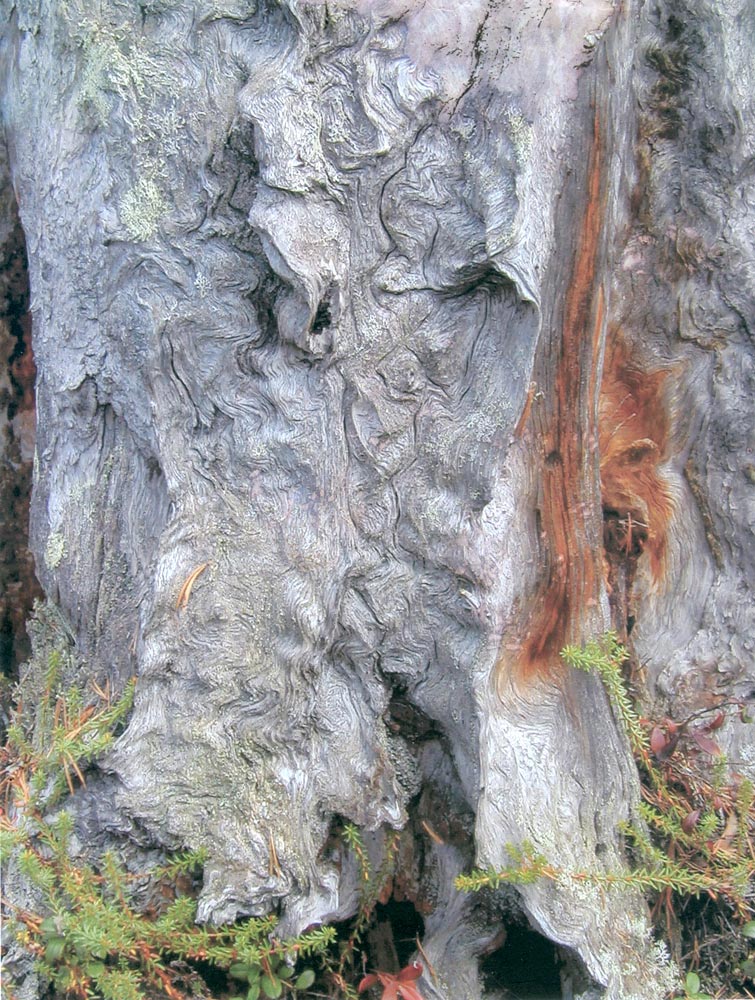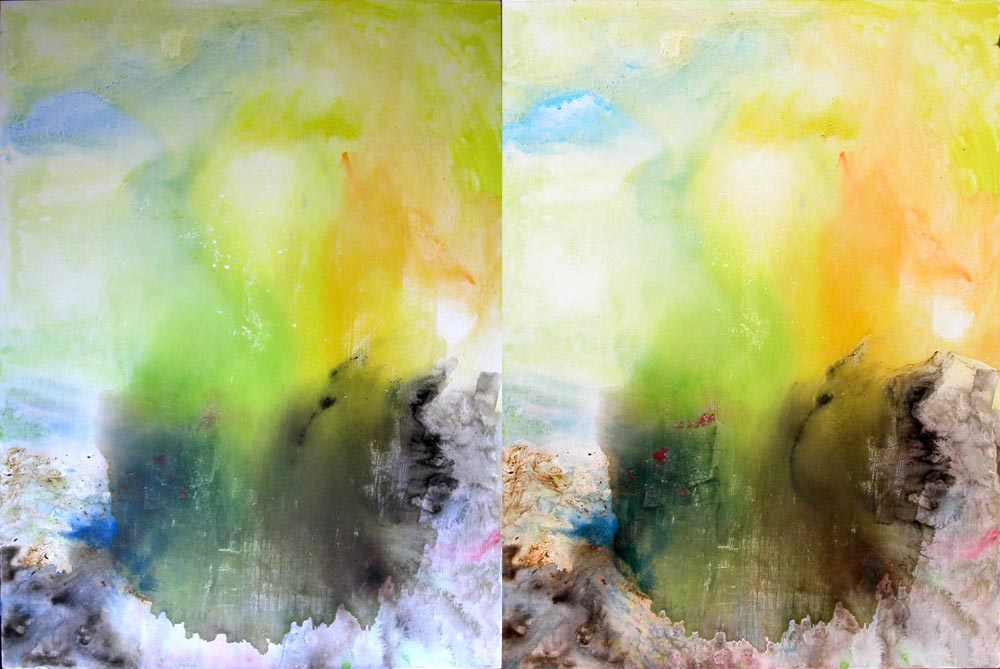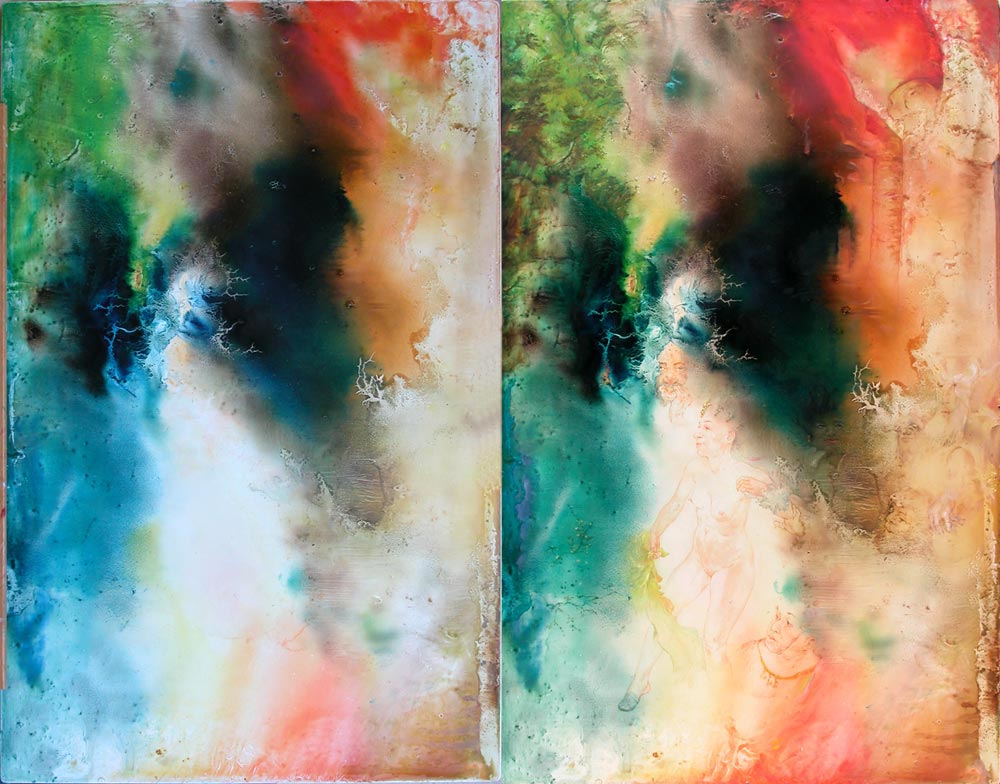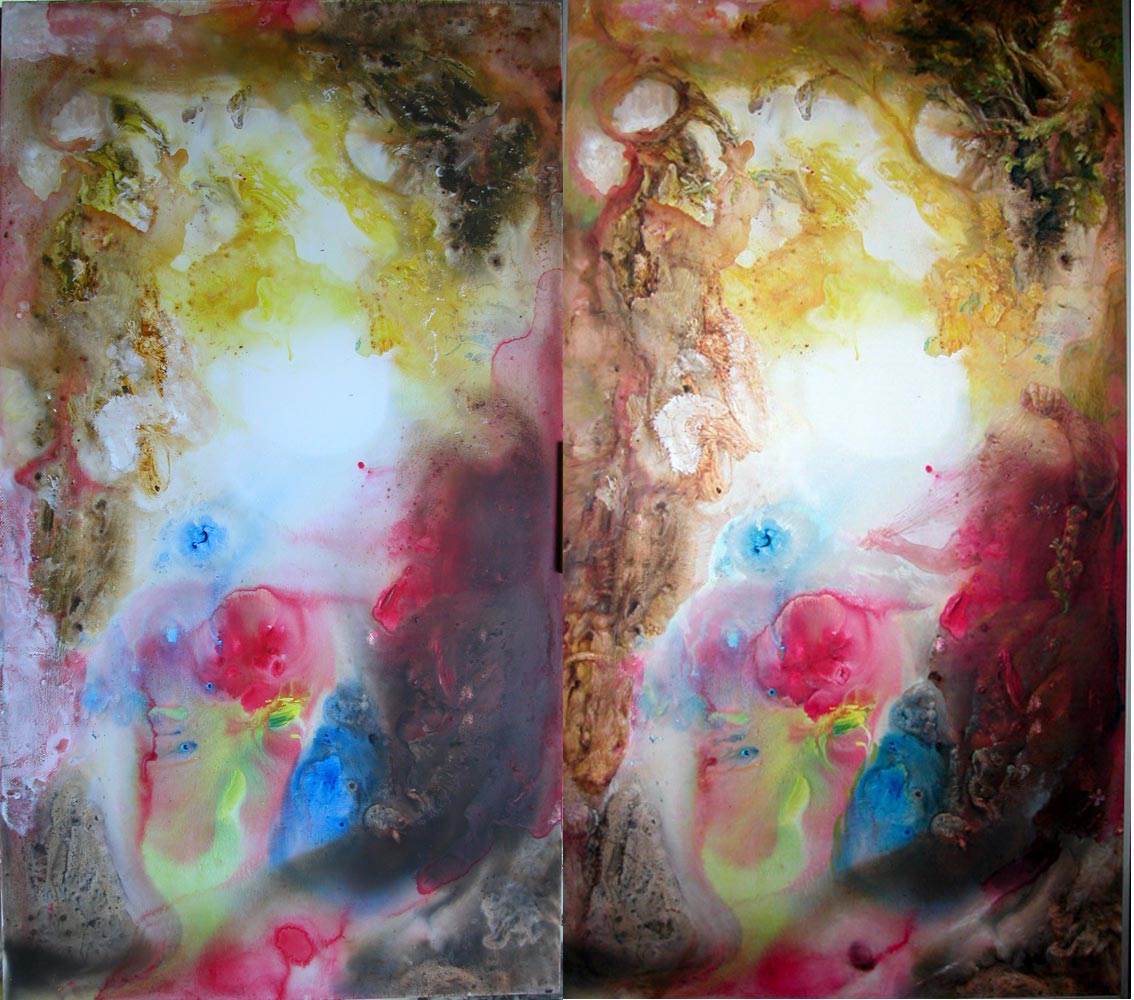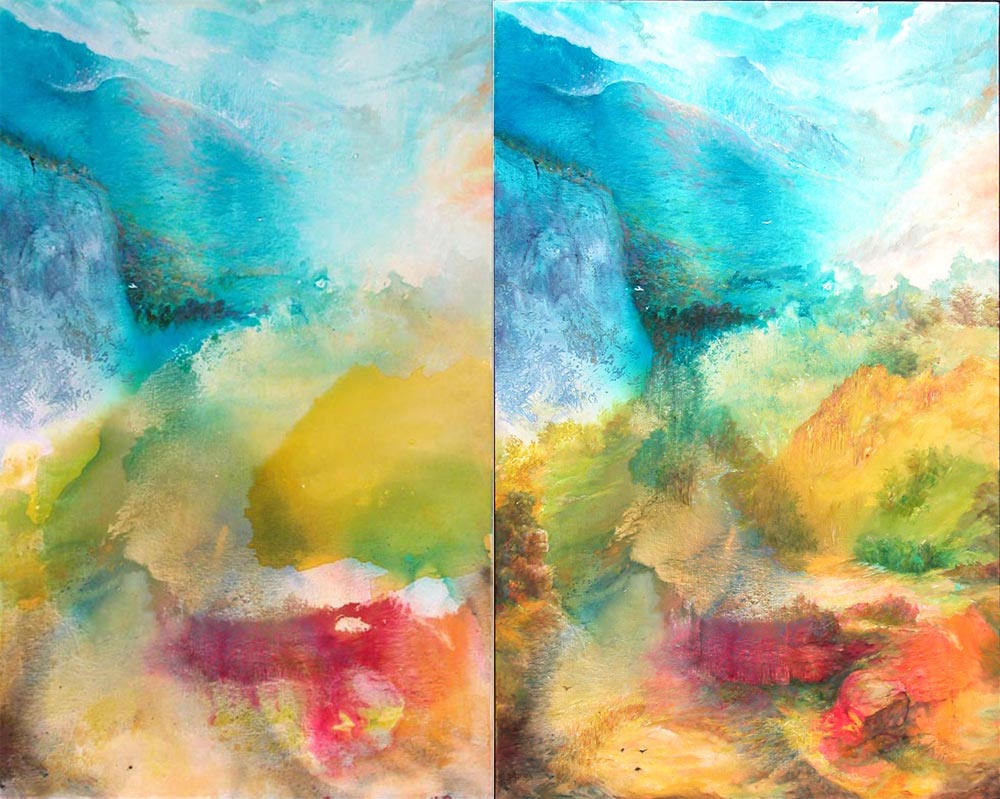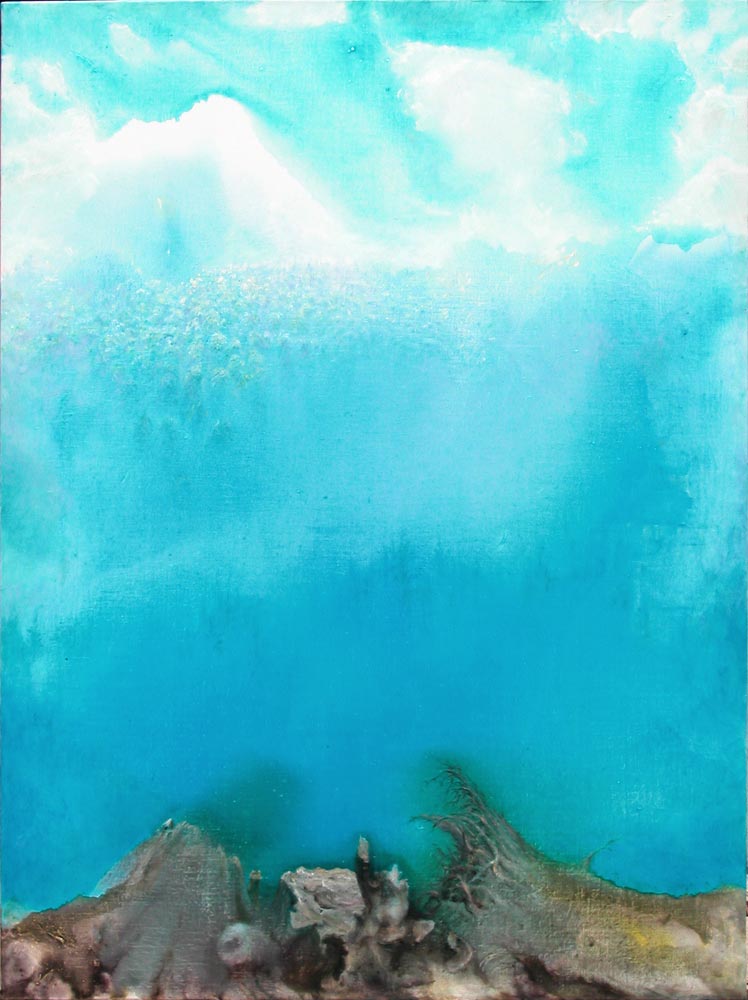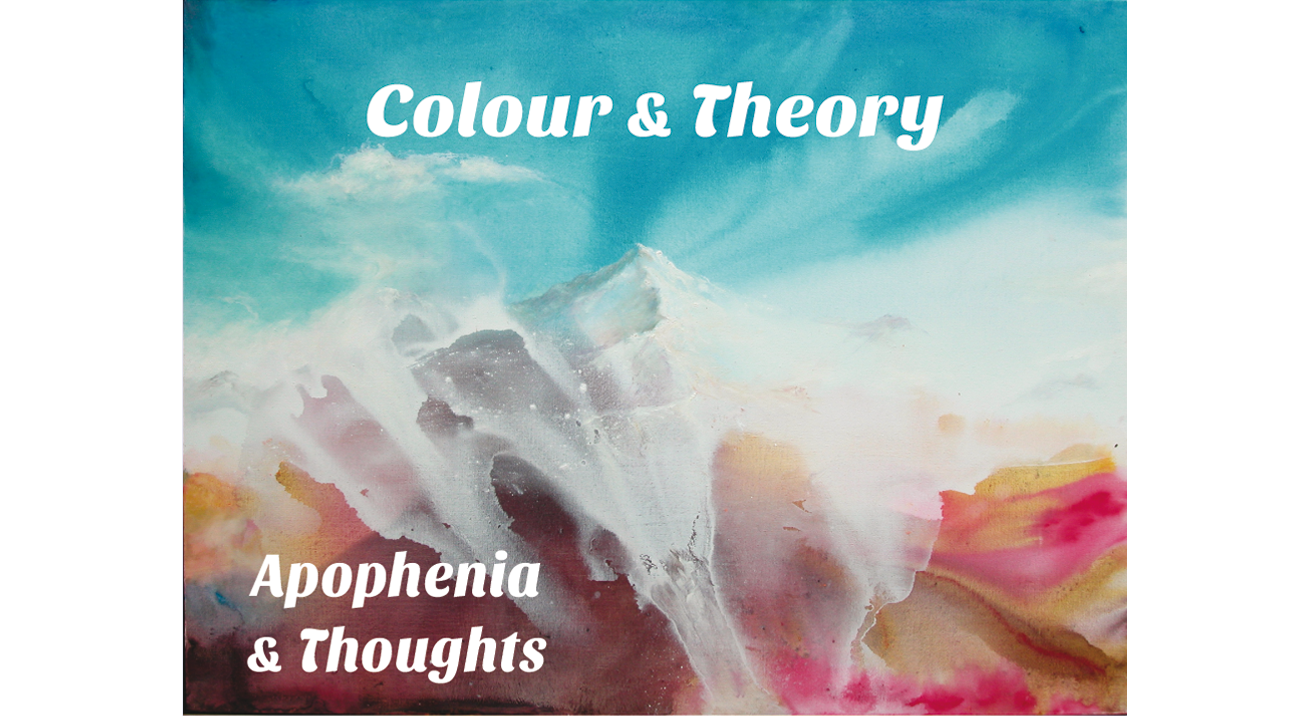
Top: Noah's cruises Gouache
Square: Mt. Blanc Acrylic and Oil on canvas
The art of seeing something that isn’t really there.
Reading meaning into ambiguous visual information.
When I was going up the stair
I met a man who wasn’t there,
He wasn’t there again today
How I wish he’d go away.
Trad.
Unilateral statement. 1. Colours
Black
White
6 primary colours -Theory (Winsor and Newton)
Unilateral 2. Content
Surrealism and Gestalt
Abstract and Realism
Archetypes
Public participation
« Chance and « hazard » I, II, III
(I see, you see, but it doesn’t mean the same thing to both of us.)
Tao and I Ching (Book of changes)
Apophenia
(constructivism)
The honourable and very ancient ability to imagine more than is immediately visible, is one that has come down to us through the centuries. It is based on the structure of the consciousness and it’s relationship with the brain. It is now accepted that the « inner » brain sees and analyses all the time. Everything is seen and sub-divided into two parts. The « ordinary », pre-encountered and analysed is catalogued and kept for future reference. This is then kept from the consciousness. What is «presented» to the conscious is the « out of the ordinary », or that which needs a more thorough analysis or reflection. (ie either it is « new » and not yet catalogued, or it has a bearing on something that is of « immediate » interest. ie. a danger)
Imagine that a cave man sees two eyes and a dark spot for a nose in the darkness of the woods. It is of the utmost importance that he decide, rapidly, whether he can eat the owner, or if the owner will eat him. Using previous experience, even a minimal amount of information must be extrapolated into a conclusion. (form of eyes, distance between eyes, position of nose in relation to eyes etc.)
Another example ; people have a job remembering the position of an object, but do not have the same problem of memory if told to « avoid » ithe previous postion. (The « position » needs a new analysis)
This ability, survival by imaginative interpretation, still exists, although in a reduced form.
Historically one of the earliest visible manifestations, a deliberate use of this phenomena, is seen in 1510 in works by Durer. It was used as an « addition » to amuse the elite, for them to « find » figures and references in paintings. Herri Met de Bles (date) was to become a leading figure using these forms in paintings. Although it did become relatively common, it was not a « mainstream » preoccupation. Rather an intellectual pastime for the elite of the time.
In « Unilateral 2 » there is a short description of how, my work paralleled this aspect of « threshold-apophenia » art. It starts from a different base. There is a piece that more fully explains « Apophenia », further down.
Here are a couple of clarifications about colour.
Unilateral statement. 1/
Colour theory.
Black
There is no part for black in the colours that I use.
Black is a negation of colour, it is not a « colour ».
Even a painted grey contains a « colour » tint if it is to integrate into a painting. Dark colours approaching black also have a basic colour to start with.
Using black and grey as a way to introduce « tone » is normally a disaster, as it reduces the colour hue, by artificially introducing a lack of light and eliminating the luminosity of the paint itself. Note Turner rarely used real black alone, (not including the deliberate use of a « White point » and a « black point » in his paintings – to dictate the « gamut » of tones used by the observer. Similra to those used in Photoshop or other photographic software, which delimit the range of tonality to be used. This in the 1680’s ! {link to add})
Naturally this excludes engravings, drawings and grisailles where colour is not used.
White
Two ways of using white, by transparency, by mixing (gives pastels) and using « pure » but as an addition. (Painting from white to dark or from dark to light)
Generally : Titanium white for skies and other « sources » of light. Zinc white for highlight or earth based colour highlights.
Other whites : Most « grounds », gesso and others, are too yellow to be used in a situation where high refractive index is called for. There are other commercial grounds, but as these generally do not have any real details about their composition (except for application). Finding the right one can be a costly business. I usually re-paint the « ground » several times if necessary.
Silver white : I had a large tube that dated from probably before the second world war. Excellent to use for skin + highlights. No longer produced. At one time lead whites were also available, but no longer.
Winsor and Newton 6 »primary » colour theory
The theory I use came from Emma Pearce, colourist at Winsor and Newton in the 1960’s. (Still available on W&N’s web site.) Who said that for artists there are six « primary-practical » colours, not three. In a circle they are « 1) Cold yellow, 2/Warm yellow - (towards reds, ie warmer.) - 3/ warm red (orange), 4/ cold red (violet,– towards blues ie colder) – 5/ cold blue (Prussian), 6/ warm blue – (,ie warmer green-blues, towards yellow). And back to cold yellow 1/(lemon, Windsor)
Or said differently, 1/ Lemon yellow . 2/ Chrome yellow. .3/ orange-scarlet red. 4/ crimson-magenta red. 5/ Prussian blue. 6/ Cyan-Turquoise blue.
Emma Pearce now proposes several versions of the six colours to use. One drawback is that most of them do not have a good lemon yellow, and there are several blues in different versions. A really acidic lemon yellow is hard to find. The cerulean and cyan, mentioned as « warm » blues, either do not really seem all that warm, or are lousy when mixed. Particularly with white. OK for « dark to White » painting (see below), but heavy-handed if transparency is called for.
Note that CYMK, subtractive or additive colours, RGB, RGV, Lab colour etc. and others, are based on three « primary » colours and are not as useful to artists, as they are rather theoretical absolutes and lack saturation and hue. (ie are rather « dead »)
There are two principal ways of organising a painting. Summarised as, dark to white. Or white to dark. The dark to white is a « traditional » method for oil paintings. Where a verdi-gris or grisaille drawing gave a base, and successive layers were added until at last a white highlight was finally added. The other way, where successive layers of colour are added, preserving the whitest parts, even letting the surface of the canvas shine through, is principally one used by water-colourists, who used the same system in their oils. (Turner, Rembrandt, or in the landscape backgrounds in the 1500’s) .
Neither of these systems is an absolute. Rembrandt, could draw veins on an old mans face, cover with semi-transparent layers, and then add highlights. Apparently not using any underpainting.
Unilateral 2/
The brain works in wonderous ways. In fact the idea of a two-depth brain, has been around for centuries. The « muse » of antiquity is the most obvious. A two-speed brain is the modern version, where the sub-conscious analyses incoming information from the senses, and « classifies » it (and chooses whether to notify the conscious or not) in an incredibly short time.
The relationship of the two functions of the brain and dreaming is less clear. Dreams do not follow a strictly practical formula.
To get round this problem I postulated that there could be a « filter » or pre-conscious which became less active at night, and allowed « overspill » in the form of dreams. It became correspondingly stronger during the day, reserving all attention for immediate experience. This is not to minimise the real virtues of dreaming (ie. allowing real-life experiences to be integrated). These days, the phenomena would be described as being limited to two functions, and dreams being simply a manifestation of emptying the « RAM (read-only-Memory) that we might have accumulated during the day. I am not overly convinced….
Starting from the postulate that the « inner » brain is just as, if not more capable than the conscious, why not profit from it ? In fact, the question rapidly became, how to provoke it ? This simple question has led me on a path, that when I started, I had no idea about where it would lead me.
The surrealists and dadaists tried to harness the power of dreams. This was to use the linking of two dissimilar thoughts, concepts or « views » as a new way to create a third. (it is one means by which creativity can be produced).
Ref. Koestler : The roots of coincidence
Gestalt. This theory whereby the brain will « correct » images, (The basis of optical illusions) shows the brains’ power to « influence » what we see. (eg.a box where the corners are less 89° or more 91°, will be seen as perfectly square). Newer experiences have shown that the brain is also capable of recognising words if the same letters are mixed in the middle and just the first and last are correct – prefctley azimang.
Gestalt theory focusses on the principal of perceptual organisation.
Archetypes. Jungian theory of the the subconscious, where the brain relates to profound « archtypes » that condition how we see the world. (You could see « mother » or Father* figures, but Jung seems to have had other archetypes in mind. I tried this, and managed to produce an « archetype » figure that, when asked « everyone » thought they had knew (or had seen this figure). Unfortunately, it was NOT the figure that I had painted to « be » the archetype, but another. Not being able to discover why, I later abandoned this line of enquiry. However, Jung remains a source. (Anythng that pertains to the human psyche is worthy of elucidation. If you want to study humanity you should also study everything that humans study themselves.)
Public « participation ». A period during which I asked the viewer to supply the « story ». This was highly productive, most people responding by using their own imagination first, and then thinking about what I had imagined. But they generally had to be asked or it was accepted that their own version was valuable.
Abstraction. This was a consideration of the use of the « abstract ». Athough the images I produce are « realist » or surrealist, the final images are figurative. Thus Abstract Art was (to me) an experiment into form, colour, texture etc. but leaving aside the « content ». It had already been thoroughly explored by the time I arrived at Art School. (Early 1960’s) Leading to an artistic impass-(dead-end) and a certain rigidity. It seemed to have become the New « Artistic canon – correctness.
I thought it was time to « re-integrate » «the other possibilities » of the artwork. (or so I thought, abstraction continues to this day to be the « norm ».). My concern was to incorporate the best of the abstract with my own experiment into content and narrative This led to the use of « abstraction » to form the base of the picture. Then re-introducing content as the next logical step.
How ? Ways of producing aleatory « forms, colour and texture » were necessary to start with.
Chance and Hazard
These became my principal line of enquiry for many years, I will break them down into sub-sections.
Chance and Hazard 1
The original idea was that, for example, if two people crossed each other in the street by accident, then IF there was a reaction (even small) , the course of the future could be changed (depending on that moment, or that encounter). So how, or what coincidence was necessary, for the meeting to happen ? Were they really « just » coincidences ? Was it pre-ordained (Future is written ?), or purely fortuitous, (independent ). Were there other factors ? (ie related to upbringing, or modifiying circumstances) and so on. Question ; how to get this apparent arbitrariness into the subjects of illustrations and etchings ? (Sub-question and answer, as I found that entirely pre-conceived artworks usually lacked spontaneity and freshness, the « hazard » of blots and other abstract marks would in some way compensate)
Chance and Hazard II
To provoke the spirit and the eye, by using abstract marks (blots, smears and textures) into finding new and original relationships between the elements of a picture. (Practical ; throw or smear ink stained tissue and other things, onto paper. Then find « images » in the resulting marks.
However, the question rapidly came up, isn’t the choice of the ink/paper/movement itself a use of « non-choice » ? To what extent is there an unconscious control over where and how the paint is applied ?
Chance and Hazard III
One advantage of chance and hazard at the start of a painting or etching is that the textures will be much more random, and add an element of « realism » by adding the aleatoire (randomness) to the overall structure. Nature is not all straight lines and perfect pixellization.
I see, you see, but they don’t mean the same thing to both of us.
As one facet of my work is the inclusion of images dredged from the sub-conscious, it became a subject of pre-occupation about how the viewer reacted. In this enquiry, where I asked individuals to interprete what they saw, was combined with a desire to involve the spectator. The spectator was asked to supply the « narrative» by using their own imagination. The results were sometimes fascinating. This was combined with the idea that once achieved, the painting no longer « belonged » to the artist, but became an independent object with it’s own future and presence.
Tao and I Ching.
The book of changes.
After « Chance and Hazard », comes coincidence . In fact – more than coincidence. It is that « more than » that became interesting. The I Ching has the ability to add a new form of definition to a work, or to propose a new « story » for a particular painting. It does not matter much if the I Ching is « consulted » before or after, although the latter gave the best results.
Again this is part of « public participation » and the ability of the brain to expand on details that are only half seen. In this case adding a literary element to the visual. The hexagrams are for the »moment » and will be superceeded later (in reality). By fixing them to a painting, they could beome a way of adding « temporality » or « possibilities » for the future. (temporality = time fixer or changer) Often remarkably relevant.
Gestalt
Gestalt theory has its focus on the principles of perceptual organisation : ‘the whole is more than the sum of the parts’
Constructivist approach
Emphasizing top-down processes in perception, the mind tries to make the best sense of ambiguous data.
Apophenia (as described by another person.)
Apophenia results from the evolution of human cognition: The ability to spot and recognize patterns-patterns that represent things to eat, things to avoid, or things with which to try and reproduce-is an adaptation with positive feedback for survival. Birds do it, bees do it, even uneducated fleas do it. Plants do it. Even one-celled micro-organisms do it. In fact, pattern recognition is the way viruses work and the ability to "do" it extends to inorganic compounds and atoms. Computers can be trained to do it. Pattern recognition is what a computer does the moment you login with a userid. Higher tech versions include digitally processed recognition of speech, faces, and even such individual and intimate traits as patterns in irises and fingerprints. However, apophenia is not just recognizing patterns. It's interpreting patterns in meaningless data as if it were meaningful.
For our hominid ancestors, pattern recognition was essential for recognizing both food and predators. Is that waving savannah grass the wind or a leopard? Is that serpentine thing on the path a root or a snake? Recognizing patterns meant the difference between life and death, but it was also a liability. Have you ever jumped when you thought the scratching on your neck was a spider when it was actually a leaf? Did your heart ever race thinking that the knocking a radiator was a rapist or a ghost? Erroneous pattern recognition can scare you. Edgar Allen Poe knew that, and wrote about it in "The Tell-Tale Heart." Life is full of risks and we can't avoid them all, nor should we.
Although all living things recognize patterns, humans may be the only ones to assign symbolic meaning-sometimes deeply nuanced or with powerful emotional content-to those patterns. Anthropologist Leslie White suggested that the tendency to create symbols is actually what makes us human. Religious symbols, intentional or not, are recognized in crosses, stars, or even lighted glories that appear around a spectacular sunset. Omens are symbols, as are patterns in the entrails of birds, tea leaves, crystal balls, birth charts, Tarot cards, and I Ching hexagrams. All of these evoke connections, sometimes pulling them from the hazy subconscious or even deep recesses of unconscious memory. Music and especially smells do this. It's what makes us feel nostalgia.
Apophenia is a normal human experience. Apophenia and pareidolia can be a boon to artists, whether visual or musical, when visual stimuli result in inspiration: Shadows suggest a nude. A birdsong can inspire a melody or machinery a composition by Philip Glass. Apophenia is helps us to appreciate puns and clever turns of phrase. His playing with pareidolia is what makes some of Salvador Dali's paintings so magical.
On 11-11-11, it's the apophenia of numerology that's relevant. Humans both love and fear patterns in numbers, whether it's lucky 7s and 11s or dangerous 13s and an evil 666. Some patterns in numbers, such as those in diagnostic medical tests or bank statements, are highly meaningful. Numerology is a form of apophenia in which numbers and patterns of numbers are considered to be meaningful. It's similar to astrology, which identifies meaningful patterns in the apparent movements of celestial bodies relative to the Earth.
It's the constant, changing interpretations of patterns that makes human experience so fascinating. In fact, pattern recognition and interpretation is fundamental to human existence. Before one can ask "What is the meaning of life?" one must first answer, "IS there a meaning of life?" Is the human condition just a serious case of apophenia? Pondering that one will keep us busy for a while
Saint Apophenia
Patron saint of fortune tellers, the mentally ill, coincidence, patternmakers, and artists
Apophenia’s birth date is unknown; images of her have been found or written about since the first century. Long standing oral tradition holds that she had visions, seeing meaningful patterns or connections in seemingly unrelated or random instances. She also had the ability to interpret the visions of others. Legend recalls her ability to spot and recognize patterns that represent things to eat or things to avoid. Her gift helped people around her to survive. Even today, people have attributed similar instances to Saint Apophenia. Her visage has been reported across the world, appearing on trees, clouds, the sides of buildings and even various food items.








